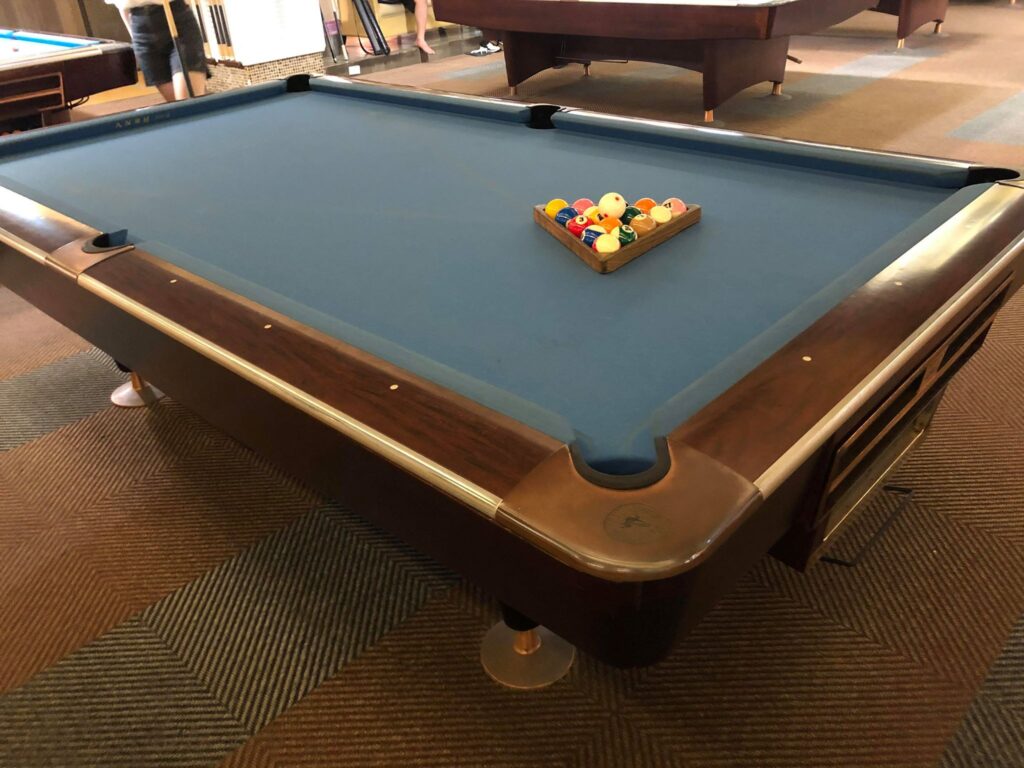Most of the tables (in Japan) are made in Japan.
The parts used are almost purely domestic.
In this article, we will talk about the table, which is an indispensable tool for playing billiards along with the ball in the previous article.
Nowadays it is common to play at a foreign-made table, but until about 40 years ago, when you think of a table, both carom and pocket billiards were almost all made in Japan, and the parts used were almost entirely made in Japan.
For example, the stone (slate) under the rasha.
Domestic slate is of higher quality, thicker and sturdier than the Italian slate that was later imported.
Rasha was also a domestic product of Nikke or Suibun.
These two companies still make Rasha, but back then the material was wool and it was mossy compared to today, the conditions were heavy and the ball didn’t run.
It was Nissho-tei and Awaji-tei that were responsible for the “shipbuilding” of these domestically produced parts. The name of the ship was “Galleon” in pocket billiards.
It stood up well compared to the American-made Brunswick, and I thought it was solid in terms of structure.
On the other hand, the carom billiard tables had no fixed name, only the emblems of table manufacturers such as Japan Tamadai and Awaji-tei.
Also, the tables back then didn’t have heaters like they do now.
I’ve seen people who know of foreign-made tables say, “I’d like to have a heater like that,” and I’ve seen an optional heater under the table.
After that, the appreciation of the yen and the billiard boom helped to bring in foreign-made tables, but before that came the “Granito”, a Spanish-made rasha for carom and billiards.
It was so thin and rolled so well, so different from the previous conditions, that everyone was surprised and bewildered for a bit, but they soon began to sneak in to use it.
As a result, it was thought that granito would become mainstream worldwide.
I was puzzled by the European-made table.
As I got used to it, I was able to do a lot of things.
However, when a tournament like the current World Cup Series was to be held, there was a company that quickly came forward to offer rasha.
That’s Ivan Simonis from France.
From then on, Simonis rasha became mainstream all over the world in one fell swoop.
Around that time, foreign-made tables began to be imported, and the Pocket Billiards “Brunswick” was made in the United States.
At Carom Billiards, European-made tables such as the “Chevirot”, “Banlare”, “Full Haven” and “Sorensogard” can be found in many of the country’s billiard halls.
At first, I was puzzled by the European table, but as I got used to using it, I was able to do a lot of things and actually felt that it was easy to hit.
In addition, since the center of carom billiards in the world was Europe, naturally European tables were used for the international tournaments.
As a result, the use of European-made tables gradually became the mainstream in Japan, and people began to play on them as “this is the only way”.
If you’re going to hit the ball in the morning
I left the bowl on the table the day before.
The hallmark of European tables then, and of course, still does today, was that they were solid.
This is a very important thing at the carom billiard table.
In carom billiards, the balls are big and heavy, and they move around in a double turn or something like that, and hard shots are required.
So to speak, compared to pocket billiards, carom billiards has more force on the table.
Therefore, if the table itself is weak, the table will shake, and if the table shakes, the ball will not slide, and you will lose power and run out of spins in the middle.
So you can’t pull a long distance or leave the spin as long as possible.
In other words, if the table is weak, it will hinder your play.
That’s why most carom tables have a steel frame in them and a thick slate, with a gross weight of about 1.2 tons.
Also, from the very beginning when European tables were imported, the tables already had heaters on them, but their role was to dry them out.
For example, if a ball with a reverse hinge goes in at a sharp angle to the cushion, the ball will curve back to the cushion it came out of after exiting the cushion.
But when the cushions are damp, they don’t get that curve.
We have heaters to prevent that from happening, but it’s unique to Japan that we use heaters mainly for drying.
The climate in Europe is often dry to begin with, so there’s not much need to dry out the table.
However, in Europe, the heaters are turned on until they are quite hot, whereas in Japan they are turned on with a whirr.
So, the original reason why I put the heater on was to warm up the ball.
The ball will be soft when warm and hard when cold.
It also changes the rebound of the ball, but in Europe it’s a lot colder, so the ball gets colder easily.
That’s why I turned on the heater to make it rebound the same way it always does.
I used to put the ball on the table the day before when I would hit it in the morning.
The heater doesn’t stay on all day, so you can leave it on the table and hit the ball as soon as it comes in, without waiting for it to warm up.
I even put a lid over the top of the bowl to keep it fully warm both above and below the bowl.
The three cushions are.
A game close to surveying that requires precision
Even in recent years, table makers have been developing and releasing new models.
When you look at the structure, you can see that it has been designed with meticulous calculations based on structural mechanics and architecture, such as how to distribute the forces.
In fact, with the improved accuracy of the table, we have been able to score more and more points on the three-cushion.
In the past, it used to be said, “That’s not a pitch you can aim for,” but now I can take it easily, and I don’t have as many “close calls” for lack of running.
Three Cushion is a game that is closer to surveying, which requires precision.
Therefore, the accuracy of the table has a direct impact on the play, and both the competitor and the viewer enjoy it.
On the other hand, I don’t think Pocket Billiards is as good as Three Cushions in terms of whether the improved table makes it possible to play more widely or to do more advanced things.
When it comes to nine balls, of course there is nothing better than a high accuracy of the table, but it is not often played by taking advantage of that, rather, I think the appeal is the unexpected play that can be seen in conditions that are becoming more difficult by the minute.
Of course, it’s also exciting to see a polished play like the “Maswari series”.




